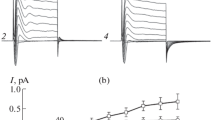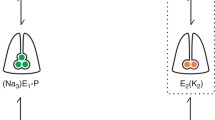Summary
The effect of ADH upon the intracellular potential and the resistance of inner and outer borders of the transport pathway was investigated on isolated skins ofRana temporaria. Within 40 min after ADH (100-300 mU/ml), the intracellular potential under short-circuit conditions decreased to about 40% of the control value (−79±4 mV), concomitant with an increase in the short-circuit current to about 160% of the control value. Amiloride, applied when steady values under ADH had been reached, caused an immediate rise of the intracellular potential to values typical for control conditions. This confirms (i) the intracellular location of the microelectrode and the absence of impalement artifacts, and (ii) the ineffectiveness of ADH upon the electromotive forces of the inner border. ADH had no effect upon the intracellular potential after blockage of the Na entry by Amiloride. The equilibrium potential of the outer border was estimated to be about +20 mV under the influence of ADH. As this value is considerably less positive than might be expected for the chemical potential of Na, a significant contribution of ions other than Na to the outer border conductance and equilibrium potential is implicated. The resistance of the outer border was more significantly decreased than that of the active transcellular pathway after ADH due to an increase in the inner border resistance, which exceeded that of the outer border after ADH. The effect of ADH upon the outer membrane characteristics would be underestimated by a factor of two, if the alterations of the electrical potential difference were not taken into consideration.
Similar content being viewed by others
References
Aceves, J. 1977. Sodium pump stimulation by oxytocin and cyclic AMP in the isolated epithelium of the frog skin.Pfluegers Arch. 371:211
Andreoli, Th.E., Schafer, J.A. 1976. Mass transport across cell membranes: The effects of antidiuretic hormone on water and solute.Annu. Rev. Physiol. 38:451
Biber, T.U.L. 1971. Effect of changes in transepithelial transport on the uptake of sodium across the outer surface of the frog skin.J. Gen. Physiol. 58:131
Biber, T.U.L., Chez, R.A., Curran, P.F. 1966. Na transport across frog skin at low external Na concentrations.J. Gen. Physiol. 49:1161
Canessa, M., Labarca, P., Leaf, A. 1976. Metabolic evidence that serosal sodium does not recycle through the active transepithelial transport pathway of toad bladder.J. Membrane Biol. 30:65
Cereijido, M., Curran, P.F. 1965. Intracellular electrical potentials in frog skin.J. Gen. Physiol. 48:543
Civan, M.M. 1970. Effects of active sodium transport on current voltage relationship of toad bladder.Am. J. Physiol. 219:234
Civan, M.M., Frazier, H.S. 1968. The site of the stimulatory action of vasopressin on sodium transport in toad bladder.J. Gen. Physiol. 51:589
Civan, M.M., Kedem, O., Leaf, A. 1966. Effect of vasopression on toad bladder under conditions of zero net sodium transport.Am. J. Physiol. 211:569
Cuthbert, A.W. 1971. Neurohypophyseal hormones and sodium transport.Phil. Trans. R. Soc. London B. 262:103
Dörge, A., Nagel, W. 1970. Effect of amiloride on sodium transport in frog skin. II. Sodium transport pool and unidirectional fluxes.Pfluegers Arch. 321:91
Dörge, A., Rick, R., Thurau, K. 1976. Characterization of the transport pool for sodium in frog skin by X-ray microanalysis.J. Physiol. 263:202P
Engbaek, L., Hoshiko, T. 1957. Electrical potential gradients through frog skin.Acta Physiol. Scand. 39:348
Finn, A.L. 1974. Transepithelial potential difference in toad urinary bladder is not due to ionic diffusion. Nature (London)250:495
Frazier, H.S. 1962. The electrical potential profile of the isolated toad bladder.J. Gen. Physiol. 45:515
Frömter, E., Gebler, B. 1977. Electrical properties of amphibian urinary epithelia. III. The cell membrane resistances and the effect of amiloride.Pfluegers Arch. 371:99
Goldman, D.E. 1943. Potential, impedance, and rectification in membranes.J. Gen. Physiol. 27:37
Helman, S.I., Fisher, R.S. 1977. Microelectrode studies of the active Na transport pathway of frog skin.J. Gen. Physiol. 69:571
Helman, S.I., Miller, D.A. 1971.In vitro techniques for avoiding edge damage in studies of frog skin.Science 173:146
Higgins, J.T., Jr., Gebler, B., Frömter, E. 1977. Electrical properties of amphibian urinary bladder epithelia. II. The cell potential profile inNecturus maculosus.Pfluegers Arch. 371:87
Hirschmann, W., Nagel, W. 1978. The outer membrane of frog skin: Impermeable to K+?Pfluegers Arch. 373:R48
Koefoed,-Johnsen, V., Ussing, H.H. 1958. The nature of the frog skin potential.Acta Physiol. Scand. 42:298
Leb, D.E., Hoshiko, T., Lindley, B.D. 1965. Effects of alkali metal cations on the potential across toad and bullfrog urinary bladder.J. Gen. Physiol. 48:527
Lindley, B.D., Hoshiko, T. 1964. The effects of alkali metal cations and common anions on the frog skin potential.J. Gen. Physiol. 47:749
Macknight, A.D.C., Leaf, A., Civan, M.M. 1971. Effects of vasopressin on the water and ionic composition of toad bladder epithelial cells.J. Membrane Biol. 6:127
Nagel, W. 1975. Reinvestigation of intracellular PD of frog skin epithelium (Abstr.) 5th International Biophysics Congress, Copenhagen
Nagel, W. 1976. The intracellular electrical potential profile of the frog skin epithelium.Pfluegers Arch. 365:135
Nagel, W. 1977. The dependence of the electrical potentials across the membranes of the frog skin upon the concentration of sodium in the mucosal solution.J. Physiol. (London) 269:777
Nagel, W., Helman, S.I. 1977. Evidence for electrogenic transport of Na in frog skin revealed in microelectrode studies using oubain.Pfluegers Arch. 368:R22
O'Neill, R.G., Helman, S.I. 1976. Influence of vasopressin and amiloride on shunt pathways of frog skin.Am. J. Physiol. 231:164
Rawlins, F., Mateu, L., Fragachan, F., Whittembury, G. 1970. Isolated toad skin epithelium: Transport characteristics.Pfluegers Arch. 316:64
Rick, R., Dörge, A., Arnim, E. von, Thurau, K. 1978. Electron microprobe analysis of frog skin epithelium: Evidence for a syncytial Na transport compartment.J. Membrane Biol. 39:3/3
Rick, R., Dörge, A., Nagel, W. 1975. Influx and efflux of sodium at the outer surface of frog skin.J. Membrane Biol. 22:183
Schultz, S.G., Frizzell, R.A., Nellans, H.N. 1977. An equivalent electrical circuit model for “sodium-transporting” epithelia in the steady-state.J. Theoret. Biol. 65:215
Sudou, K., Hoshi, T. 1977. Mode of action of amiloride in toad urinary bladder. An electrophysiological study of the drug action on sodium permeability of the mucosal border.J. Membrane Biol. 32:115
Ussing, H.H., Windhager, E.E. 1964. Nature of shunt path and active sodium transport path through frog skin epithelium.Acta Physiol. Scand. 61:484
Ussing, H.H., Zerahn, K. 1950. Active transport of sodium as the source of electric current in the short-circuited isolated frog. skin.Acta Physiol. Scand. 23:110
Whittembury, G. 1964. Electrical potential profile of the toad skin epithelium.J. Gen. Physiol. 47:795
Winn, P.M., La Prade, N.S., Tolbert, W.R., Huf, E.G. 1966. On the nature of the resting frog skin potential.MCVQ Med. Coll. Va Q. 2(2):116
Yonath, J., Civan, M.M. 1971. Determination of the driving force of the Na+ pump in toad bladder by means of vasopressin.J. Membrane Biol. 5:366
Author information
Authors and Affiliations
Rights and permissions
About this article
Cite this article
Nagel, W. Effects of antidiuretic hormone upon electrical potential and resistance of apical and basolateral membranes of frog skin. J. Membrain Biol. 42, 99–122 (1978). https://doi.org/10.1007/BF01885366
Received:
Revised:
Issue Date:
DOI: https://doi.org/10.1007/BF01885366




